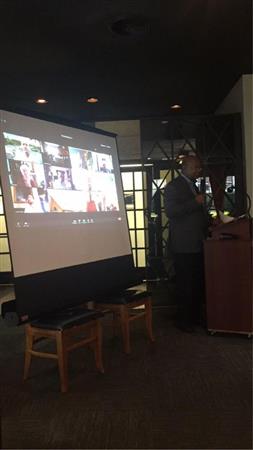
Adopting the Hybrid Meeting concept
for Rotary Club meetings requires
considerable planning as we adapt.
I've done a lot of investigation of this format for our Rotary Club - there are a LOT of people who are actively attempting to do this. You start off by clarifying exactly what the goals are:
- All attendees should fully achieve the purposes of the meeting (usually education, socializing, disseminating announcements, etc.)
- All attendees should be as engaged as everyone else and feel that they achieved their purpose
Next, clarify the different environments you'll be using. You'd think that "in the room" would be obvious, but it's not. What kind of room? Is there a "stage" area where presenters are? Are people allowed/encouraged to leave their seats?
Likewise, "on Zoom" is not obvious. Accessing from a computer, tablet, or phone? Able to view video? In the office, couch, back porch, or car? In an environment where it's easy to speak up on real time? Often you don't really have much control over any of this because each individual can choose to engage however they wish, but it really helps to figure out if you want or need to constrain peoples' Zoom participation.
Next, clarify all the roles which take place. In-person participant, Zoom participant, presenter, meeting host, tech facilitator(s), discussion leaders, etc.
NOW you can start thinking about what this implies for the design of the tech and the meeting flow. You realize quickly that you need bi-directional audio and video where everybody can see and hear everything important that's going on. For us, this has meant:
Likewise, "on Zoom" is not obvious. Accessing from a computer, tablet, or phone? Able to view video? In the office, couch, back porch, or car? In an environment where it's easy to speak up on real time? Often you don't really have much control over any of this because each individual can choose to engage however they wish, but it really helps to figure out if you want or need to constrain peoples' Zoom participation.
Next, clarify all the roles which take place. In-person participant, Zoom participant, presenter, meeting host, tech facilitator(s), discussion leaders, etc.
NOW you can start thinking about what this implies for the design of the tech and the meeting flow. You realize quickly that you need bi-directional audio and video where everybody can see and hear everything important that's going on. For us, this has meant:
Video
- Camera trained on the presenter area in the room
- Camera trained on the audience in the room (perhaps even able to zoom in on particular individuals or things of interest)
- A screen in the room showing the Zoom participants on the call, managed in real-time to show what's of interest (Zoom speaker, gallery view, slides being shared)
- A screen in the room showing the slides of the in-the-room speaker, which is also connected to showing those on Zoom
Audio
- The usual microphone/speakers for each Zoom participant
- A microphone at the "front of the room" (could be a Lavalier) which broadcasts to loudspeakers in the room and on Zoom
- A microphone for the audience in the room, with the understanding that all useful comments in the room must be heard on Zoom as well
- Loudspeakers in the room so that everybody can hear what someone says on Zoom
- (When this is done in a conference room, often these days each and every person in the room has their own microphone. That tends to be impractical in a larger room.)
Pandemic considerations
- With pandemic restrictions, it is common that multiple people must not touch a microphone so that leads you to people changing position rather than passing a microphone around.
- When people in the room speak through a mask, it can be harder to understand for EVERYBODY. This may impact the configuration of the room, such as putting the speaker further away from the audience.
- People in the room have to be spaced much further apart than would be preferable - an impediment to interaction in the room, but also harder to capture for the Zoom participants
Tech management
- For this much stuff, we've found it useful to have TWO people managing the tech in the room:Pointing the camera in the right place
- Ensuring the correct camera is being shown on Zoom
- Making sure people step up to the microphone to ask questions or be a speaker
- Adjusting audio levels
- Putting the most appropriate Zoom display on the screen
Highlighting the right person for the Zoom participants - Watching hand-raising, chat, and interjecting into the room as appropriate
- Addressing Zoom glitches
- Addressing glitches with all the stuff in the room
Zoom recording
Equipment in the room
- 2 microphones, loudspeakers
- 2 high quality cameras
- 2 computers with high speed internet
- audio mixer and video switcher
- 1 or 2 projectors and screens
- A whole boatload of wires
Clearly the meeting flow has to be pretty well structured, with planned changes between the modes of one-speaker, speaker-with-slides, Q&A, interactive-conversation, etc. This planning will help the tech manager(s) to reconfigure stuff in the appropriate ways.
Stuff we haven't figured out yet:
Stuff we haven't figured out yet:
- Breakout rooms which include people both on Zoom and in the room (solution so far is to have small table groups in the room, and breakout rooms on Zoom, but not interacting with each other)
- Random conversation you'd like to encourage between the two groups (pre-event, post-event, during breaks)
- How to handle more than the 25 Zoom participants you can show in Gallery View
- Having everybody in the room be able to see the chat and hand-raising
- Interactive Zoom features such as screen annotation
- Having BOTH the Zoom gallery and speaker view shown at the same time